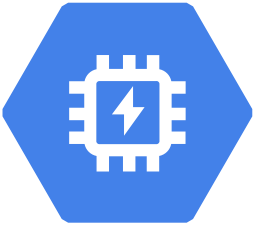MNIST on TPU (Tensor Processing Unit)
or GPU using tf.Keras and tf.data.Dataset
 |
This sample trains an "MNIST" handwritten digit recognition model on a GPU or TPU backend using a Keras model. Data are handled using the tf.data.Datset API. This is a very simple sample provided for educational purposes. Do not expect outstanding TPU performance on a dataset as small as MNIST.
 Train on GPU or TPU
Train on GPU or TPU 
- Select a GPU or TPU backend (Runtime > Change runtime type)
- Run all cells up to and including "Train and validate the model" and "Visualize predictions".
 Deploy to AI Platform
Deploy to AI Platform
- Configure a Google cloud project and bucket as well as the desired model name in "Deploy the trained model".
- Run the remaining cells to the end to deploy your model to Cloud AI Platform Prediction and test the deployment.
TPUs are located in Google Cloud, for optimal performance, they read data directly from Google Cloud Storage (GCS).
import os, re, time, json
import PIL.Image, PIL.ImageFont, PIL.ImageDraw
import numpy as np
import tensorflow as tf
from matplotlib import pyplot as plt
AUTOTUNE = tf.data.AUTOTUNE
print("Tensorflow version " + tf.__version__)
Visualization utilities¶
#@title visualization utilities [RUN ME]
"""
This cell contains helper functions used for visualization
and downloads only. You can skip reading it. There is very
little useful Keras/Tensorflow code here.
"""
# Matplotlib config
plt.rc('image', cmap='gray_r')
plt.rc('grid', linewidth=0)
plt.rc('xtick', top=False, bottom=False, labelsize='large')
plt.rc('ytick', left=False, right=False, labelsize='large')
plt.rc('axes', facecolor='F8F8F8', titlesize="large", edgecolor='white')
plt.rc('text', color='a8151a')
plt.rc('figure', facecolor='F0F0F0')# Matplotlib fonts
MATPLOTLIB_FONT_DIR = os.path.join(os.path.dirname(plt.__file__), "mpl-data/fonts/ttf")
# pull a batch from the datasets. This code is not very nice, it gets much better in eager mode (TODO)
def dataset_to_numpy_util(training_dataset, validation_dataset, N):
# get one batch from each: 10000 validation digits, N training digits
batch_train_ds = training_dataset.unbatch().batch(N)
# eager execution: loop through datasets normally
for validation_digits, validation_labels in validation_dataset:
validation_digits = validation_digits.numpy()
validation_labels = validation_labels.numpy()
break
for training_digits, training_labels in batch_train_ds:
training_digits = training_digits.numpy()
training_labels = training_labels.numpy()
break
# these were one-hot encoded in the dataset
validation_labels = np.argmax(validation_labels, axis=1)
training_labels = np.argmax(training_labels, axis=1)
return (training_digits, training_labels,
validation_digits, validation_labels)
# create digits from local fonts for testing
def create_digits_from_local_fonts(n):
font_labels = []
img = PIL.Image.new('LA', (28*n, 28), color = (0,255)) # format 'LA': black in channel 0, alpha in channel 1
font1 = PIL.ImageFont.truetype(os.path.join(MATPLOTLIB_FONT_DIR, 'DejaVuSansMono-Oblique.ttf'), 25)
font2 = PIL.ImageFont.truetype(os.path.join(MATPLOTLIB_FONT_DIR, 'STIXGeneral.ttf'), 25)
d = PIL.ImageDraw.Draw(img)
for i in range(n):
font_labels.append(i%10)
d.text((7+i*28,0 if i<10 else -4), str(i%10), fill=(255,255), font=font1 if i<10 else font2)
font_digits = np.array(img.getdata(), np.float32)[:,0] / 255.0 # black in channel 0, alpha in channel 1 (discarded)
font_digits = np.reshape(np.stack(np.split(np.reshape(font_digits, [28, 28*n]), n, axis=1), axis=0), [n, 28*28])
return font_digits, font_labels
# utility to display a row of digits with their predictions
def display_digits(digits, predictions, labels, title, n):
plt.figure(figsize=(13,3))
digits = np.reshape(digits, [n, 28, 28])
digits = np.swapaxes(digits, 0, 1)
digits = np.reshape(digits, [28, 28*n])
plt.yticks([])
plt.xticks([28*x+14 for x in range(n)], predictions)
for i,t in enumerate(plt.gca().xaxis.get_ticklabels()):
if predictions[i] != labels[i]: t.set_color('red') # bad predictions in red
plt.imshow(digits)
plt.grid(None)
plt.title(title)
# utility to display multiple rows of digits, sorted by unrecognized/recognized status
def display_top_unrecognized(digits, predictions, labels, n, lines):
idx = np.argsort(predictions==labels) # sort order: unrecognized first
for i in range(lines):
display_digits(digits[idx][i*n:(i+1)*n], predictions[idx][i*n:(i+1)*n], labels[idx][i*n:(i+1)*n],
"{} sample validation digits out of {} with bad predictions in red and sorted first".format(n*lines, len(digits)) if i==0 else "", n)
# utility to display training and validation curves
def display_training_curves(training, validation, title, subplot):
if subplot%10==1: # set up the subplots on the first call
plt.subplots(figsize=(10,10), facecolor='#F0F0F0')
plt.tight_layout()
ax = plt.subplot(subplot)
ax.grid(linewidth=1, color='white')
ax.plot(training)
ax.plot(validation)
ax.set_title('model '+ title)
ax.set_ylabel(title)
ax.set_xlabel('epoch')
ax.legend(['train', 'valid.'])
TPU or GPU detection¶
try: # detect TPUs
tpu = tf.distribute.cluster_resolver.TPUClusterResolver.connect() # TPU detection
strategy = tf.distribute.TPUStrategy(tpu)
except ValueError: # detect GPUs
strategy = tf.distribute.MirroredStrategy() # for GPU or multi-GPU machines
#strategy = tf.distribute.get_strategy() # default strategy that works on CPU and single GPU
#strategy = tf.distribute.experimental.MultiWorkerMirroredStrategy() # for clusters of multi-GPU machines
print("Number of accelerators: ", strategy.num_replicas_in_sync)
Parameters¶
BATCH_SIZE = 64 * strategy.num_replicas_in_sync # Gobal batch size.
# The global batch size will be automatically sharded across all
# replicas by the tf.data.Dataset API. A single TPU has 8 cores.
# The best practice is to scale the batch size by the number of
# replicas (cores). The learning rate should be increased as well.
LEARNING_RATE = 0.01
LEARNING_RATE_EXP_DECAY = 0.6 if strategy.num_replicas_in_sync == 1 else 0.7
# Learning rate computed later as LEARNING_RATE * LEARNING_RATE_EXP_DECAY**epoch
# 0.7 decay instead of 0.6 means a slower decay, i.e. a faster learnign rate.
training_images_file = 'gs://mnist-public/train-images-idx3-ubyte'
training_labels_file = 'gs://mnist-public/train-labels-idx1-ubyte'
validation_images_file = 'gs://mnist-public/t10k-images-idx3-ubyte'
validation_labels_file = 'gs://mnist-public/t10k-labels-idx1-ubyte'
tf.data.Dataset: parse files and prepare training and validation datasets¶
Please read the best practices for building input pipelines with tf.data.Dataset
def read_label(tf_bytestring):
label = tf.io.decode_raw(tf_bytestring, tf.uint8)
label = tf.reshape(label, [])
label = tf.one_hot(label, 10)
return label
def read_image(tf_bytestring):
image = tf.io.decode_raw(tf_bytestring, tf.uint8)
image = tf.cast(image, tf.float32)/256.0
image = tf.reshape(image, [28*28])
return image
def load_dataset(image_file, label_file):
imagedataset = tf.data.FixedLengthRecordDataset(image_file, 28*28, header_bytes=16)
imagedataset = imagedataset.map(read_image, num_parallel_calls=16)
labelsdataset = tf.data.FixedLengthRecordDataset(label_file, 1, header_bytes=8)
labelsdataset = labelsdataset.map(read_label, num_parallel_calls=16)
dataset = tf.data.Dataset.zip((imagedataset, labelsdataset))
return dataset
def get_training_dataset(image_file, label_file, batch_size):
dataset = load_dataset(image_file, label_file)
dataset = dataset.cache() # this small dataset can be entirely cached in RAM
dataset = dataset.shuffle(5000, reshuffle_each_iteration=True)
dataset = dataset.repeat()
dataset = dataset.batch(batch_size)
dataset = dataset.prefetch(AUTOTUNE) # fetch next batches while training on the current one (-1: autotune prefetch buffer size)
return dataset
def get_validation_dataset(image_file, label_file):
dataset = load_dataset(image_file, label_file)
dataset = dataset.cache() # this small dataset can be entirely cached in RAM
dataset = dataset.batch(10000)
return dataset
# instantiate the datasets
training_dataset = get_training_dataset(training_images_file, training_labels_file, BATCH_SIZE)
validation_dataset = get_validation_dataset(validation_images_file, validation_labels_file)
Let's have a look at the data¶
N = 24
(training_digits, training_labels,
validation_digits, validation_labels) = dataset_to_numpy_util(training_dataset, validation_dataset, N)
display_digits(training_digits, training_labels, training_labels, "training digits and their labels", N)
display_digits(validation_digits[:N], validation_labels[:N], validation_labels[:N], "validation digits and their labels", N)
font_digits, font_labels = create_digits_from_local_fonts(N)
Keras model: 3 convolutioal layers, 2 dense layers¶
# This model trains to 99.4% accuracy in 10 epochs (with a batch size of 64)
def make_model():
model = tf.keras.Sequential(
[
tf.keras.layers.Reshape(input_shape=(28*28,), target_shape=(28, 28, 1), name="image"),
tf.keras.layers.Conv2D(filters=12, kernel_size=3, padding='same', use_bias=False), # no bias necessary before batch norm
tf.keras.layers.BatchNormalization(scale=False, center=True), # no batch norm scaling necessary before "relu"
tf.keras.layers.Activation('relu'), # activation after batch norm
tf.keras.layers.Conv2D(filters=24, kernel_size=6, padding='same', use_bias=False, strides=2),
tf.keras.layers.BatchNormalization(scale=False, center=True),
tf.keras.layers.Activation('relu'),
tf.keras.layers.Conv2D(filters=32, kernel_size=6, padding='same', use_bias=False, strides=2),
tf.keras.layers.BatchNormalization(scale=False, center=True),
tf.keras.layers.Activation('relu'),
tf.keras.layers.Flatten(),
tf.keras.layers.Dense(200, use_bias=False),
tf.keras.layers.BatchNormalization(scale=False, center=True),
tf.keras.layers.Activation('relu'),
tf.keras.layers.Dropout(0.4), # Dropout on dense layer only
tf.keras.layers.Dense(10, activation='softmax')
])
model.compile(optimizer='adam', # learning rate will be set by LearningRateScheduler
loss='categorical_crossentropy',
metrics=['accuracy'])
# Going back and forth between TPU and host is expensive. Better to run 128 batches on the TPU before reporting back.
return model
with strategy.scope():
model = make_model()
# print model layers
model.summary()
# set up learning rate decay
lr_decay = tf.keras.callbacks.LearningRateScheduler(
lambda epoch: LEARNING_RATE * LEARNING_RATE_EXP_DECAY**epoch,
verbose=True)
Train and validate the model¶
EPOCHS = 10
steps_per_epoch = 60000//BATCH_SIZE # 60,000 items in this dataset
print("Steps per epoch: ", steps_per_epoch)
history = model.fit(training_dataset,
steps_per_epoch=steps_per_epoch, epochs=EPOCHS,
validation_data=validation_dataset, validation_steps=1,
callbacks=[lr_decay])
Visualize predictions¶
# recognize digits from local fonts
probabilities = model.predict(font_digits, steps=1)
predicted_labels = np.argmax(probabilities, axis=1)
display_digits(font_digits, predicted_labels, font_labels, "predictions from local fonts (bad predictions in red)", N)
# recognize validation digits
probabilities = model.predict(validation_digits, steps=1)
predicted_labels = np.argmax(probabilities, axis=1)
display_top_unrecognized(validation_digits, predicted_labels, validation_labels, N, 7)
Deploy the trained model to AI Platform prediction¶
Push your trained model to production on AI Platform for a serverless, autoscaled, REST API experience.
You will need a GCS (Google Cloud Storage) bucket and a GCP project for this. Models deployed on AI Platform autoscale to zero if not used. There will be no AI Platform charges after you are done testing. Google Cloud Storage incurs charges. Empty the bucket after deployment if you want to avoid these. Once the model is deployed, the bucket is not useful anymore.
Google Cloud Platform に deploy しないので、以下は省略。